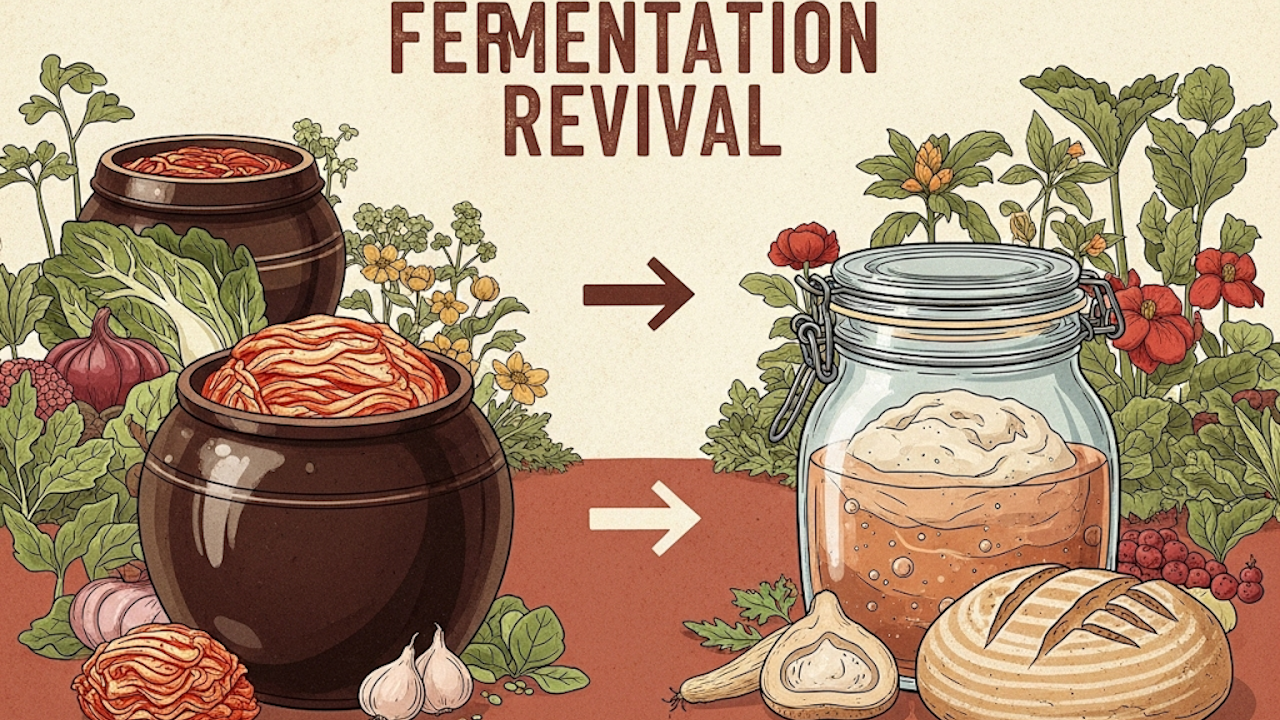The world of food is experiencing a profound transformation, a quiet revolution fueled by the rediscovery of ancient techniques. At its heart lies fermentation, a process that for millennia has been central to human sustenance, but which for a time receded into the background of industrial food production. Now, from the fiery depths of kimchi to the tangy embrace of sourdough, fermentation is not just back; it’s thriving, captivating chefs, home cooks, and health enthusiasts alike.
This revival is more than a culinary trend; it’s a movement rooted in a desire for flavor, nutrition, and a deeper connection to the food we eat. Once considered a mere preservation method, fermentation is now celebrated for its ability to unlock complex flavor profiles, enhance nutrient bioavailability, and introduce beneficial microorganisms into our diet.
The Ancient Art, Reimagined
Fermentation, at its core, is a metabolic process in which microorganisms like yeast and bacteria convert carbohydrates into alcohol, gases, or organic acids. This transformation not only preserves food but also fundamentally alters its texture, aroma, and taste. Think of the humble grape transforming into wine, milk into cheese, or cabbage into sauerkraut. These are not just chemical reactions; they are acts of culinary alchemy, guided by the invisible hand of microbial life.
For centuries, fermentation was a household art, passed down through generations. Grandmothers tended bubbling crocks of pickles, sourdough starters were heirlooms, and every culture developed its own unique fermented staples. The advent of refrigeration and industrial food processing, however, led to a decline in these traditional practices. Foods became standardized, shelf life prioritized over nuanced flavor, and the vibrant microbial world of our food was largely sterilized away.
Kimchi: A Spicy Gateway to Gut Health
Few foods embody the fermentation revival as vibrantly as kimchi. This iconic Korean staple, a fiery concoction of fermented napa cabbage and a medley of spices, has transcended its cultural origins to become a global phenomenon. Beyond its irresistible umami and spicy kick, kimchi is a powerhouse of probiotics, the beneficial bacteria that contribute to a healthy gut microbiome.
The intricate process of making kimchi involves salting the cabbage to draw out moisture, then massaging it with a paste of gochugaru (Korean chili powder), garlic, ginger, and various other aromatics. Over days or weeks, lactic acid bacteria naturally present on the cabbage begin their work, transforming the ingredients into a complex, tangy, and deeply satisfying food. The growing scientific understanding of the gut brain axis and the role of gut health in overall well being has only amplified kimchi’s appeal, positioning it as not just a delicious condiment but a functional food.
Sourdough: The Bread That Breathed Again
Parallel to kimchi’s ascent, sourdough bread has experienced a renaissance of its own. For many, the act of nurturing a sourdough starter, a living culture of wild yeast and lactic acid bacteria, has become a meditative ritual. This process, requiring patience and observation, stands in stark contrast to the instant gratification of commercial yeast breads.
Sourdough’s distinct tang, its chewy crumb, and its deeply satisfying crust are all testament to the slow, enzymatic breakdown of starches and proteins by the microorganisms in the starter. This extended fermentation also makes the nutrients in the flour more bioavailable and can even reduce the glycemic index of the bread. From artisanal bakeries to home kitchens, the rhythmic bubbling of sourdough starters and the comforting aroma of freshly baked loaves are now commonplace, a symbol of a return to simpler, more intentional food practices.
Beyond Kimchi and Sourdough: A World of Fermented Wonders
The fermentation revival extends far beyond these two iconic examples. Kombucha, a fizzy, tangy fermented tea, has moved from health food stores to mainstream supermarkets. Kefir, a fermented milk drink rich in probiotics, is increasingly popular. Miso, tempeh, natto, and an array of fermented vegetables are finding their way onto more plates, introducing diverse flavors and nutritional benefits.
Chefs are experimenting with fermented ingredients to add layers of complexity to their dishes, creating umami rich sauces, tangy dressings, and unique flavor combinations. Home cooks are eagerly attending workshops, sharing recipes online, and rediscovering the joy of hands on food preparation. Specialized crocks, airlocks, and books dedicated to fermentation are flying off the shelves, testament to the growing enthusiasm.
The Future is Fermented
The fermentation revival is more than a fleeting trend. It represents a fundamental shift in how we view and interact with our food. It’s about empowering individuals to take control of their food choices, to embrace the natural processes that transform raw ingredients into nourishing and delicious meals. It’s about reconnecting with ancient wisdom and appreciating the invisible world of microorganisms that play such a vital role in our health and our culinary heritage.
As we continue to explore the intricate relationship between our diet and our well being, and as the desire for authentic, flavorful, and sustainable food grows, fermentation will undoubtedly remain at the forefront of this culinary evolution. From the humble cabbage to the simple grain, the possibilities are endless, and the future of food, it seems, is deliciously, vibrantly, and healthily fermented.

